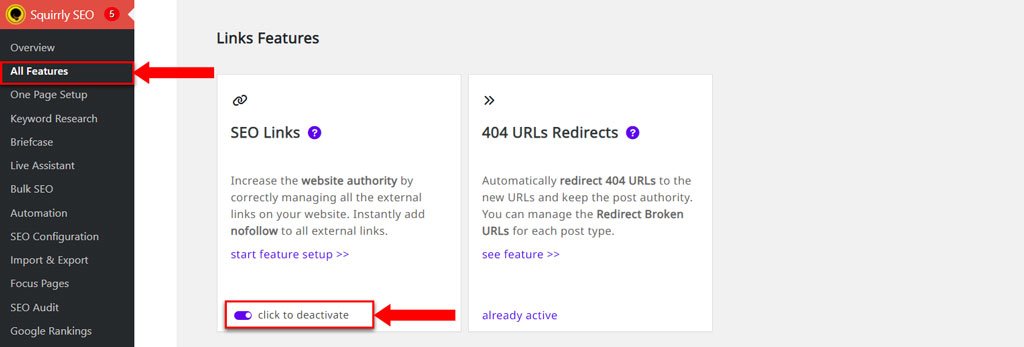SEO Links and Redirects

The SEO Links and Redirects section of Squirrly SEO is all about helping you increase your website’s Authority by giving you more control over how you manage it.
In this section, you can:
- Redirect attachment pages
- Add nofollow to external links
- Open external links in a New Tab
We’ll go through each one of them and explain what it does and what benefits it offers you.
But first, let’s take a look at how you can get access to this section of the plugin.
How to Access SEO Links and Redirects

Enable SEO LINKS and Redirects

By default, the SEO LINKS and Redirects section is NOT active.
One of the reasons for this is that some of you may already be using other plugins that provide the same functionality (for example, plugins for adding the “nofollow” attribute to external links such as the WP External Links plugin).
To be able to start using the options from the SEO Links section, you first need to activate from All Features > SEO Links.

Redirect Attachments Page
- To reach this option, go to: Squirrly SEO > Technical SEO > Tweaks and Sitemaps > SEO Links and Redirects > Redirect Attachments Page
By default, this option is ACTIVE. (! note that the Redirect Attachments Page option belongs to the global feature SEO Links which is NOT active by default. So, the Redirect Attachments Page option will ONLY be active by default IF you enable the global SEO Links feature)
If you’re not into development, you may be surprised to find out that WordPress creates a separate media attachment page for every file you upload to the Media Library.
The page has its own automatically-generated URL – and ONLY contains the media content.
Having these types of pages indexed by Google can hurt your SEO in a few different ways:
- Say you create an article and add 2 images to it. WordPress will generate 3 separate URLs – 2 for your images and one for your original article. Google may start sending more visitors to the attachment pages instead of the original article to which they belong – especially if you’ve optimized your images.
- Visitors who reach your attachment pages will just see an image and nothing else. With no context to help them make sense of your page, they are likely to leave right away (therefore increasing your bounce rate).
- Google might index all the image files and consider them as duplicate content.
You can stop Google from indexing your WordPress image attachments pages by redirecting them to the actual images.
Using the Redirect Attachments Page option, you can this with one move.
When the toggle is switched to the right, the Redirect Attachments Page option is active.
Having this option active means that when someone lands on one of your attachments pages, they will be redirected to the attachment itself.
Best Practice
- Unless you have a photography website, we recommend activating this option. If you have a photography site, we recommend optimizing your Attachments Pages and turning this option OFF. Otherwise, activating the Redirect Attachments Page option is the way to go.

Nofollow External Links
- To reach this option, go to: Squirrly SEO > Technical SEO > Tweaks and Sitemaps > SEO Links and Redirects > Add Nofollow to External Links
By default, this option is ACTIVE. (! note that the Nofollow External Links option belongs to the global feature SEO Links which is NOT active by default. So, the Nofollow External Links option will ONLY be active by default IF you enable the global SEO Links feature)
This option helps you correctly manage all external links by turning all external links to nofollow links.
Nofollow links are links with a rel=”nofollow” HTML tag applied to them. By applying the nofollow tag to your external links, you’re basically telling search engines to ignore them and pass absolutely no link authority (link juice) to the websites you link to.
Using nofollow for external links helps you stop losing Authority.
When the toggle is switched to the right, the Add Nofollow to external links option is active.
Having this option active means that all external links from an article will have a rel=”nofollow” HTML tag applied to them.

Domain Exception
- To reach this option, go to: Squirrly SEO > Technical SEO > Tweaks and Sitemaps > SEO Links and Redirects > Domain Exception
What if you want to link to certain external websites and have those links be follow links? (follow links are links that pass link authority, boosting the page rank of the linked-to sites, helping them achieve better positions in the SERPs as a result.)
You can exclude those external websites by adding them as exceptions in the Domain Exception section.
This way, Squirrly will NOT add the rel=”nofollow” HTML tag to links that point to domains included in this list.
- There is NO limit to how many domains you can add to this list;
- Separate domain URLs by a line break (as shown in the screenshot below)

Open External Links in New Tab
- To reach this option, go to: Squirrly SEO > Technical SEO > Tweaks and Sitemaps > SEO Links and Redirects > Open External Links in New Tab
By default, this option is ACTIVE. (! note that the Open External Links in New Tab option belongs to the global feature SEO Links which is NOT active by default. So, the Open External Links in New Tab option will ONLY be active by default IF you enable the global SEO Links feature)
In general, external links should always open in a new browser tab because your goal in designing a website is to get more visitors to convert. And letting an external link replace your website in the open tab goes against that purpose.
On the other hand, opening external links in a new tab allows visitors to explore the other site(s) you’re pointing to as much as they want without having to hit the back button over and over again to return to your site.
This improves their experience, and increases the likelihood of them coming back to your page.
But, be honest – how many times did you forget to make that setting that enables your external links to open in a new tab?
By activating this option from SEO Links, you won’t have to set this up manually on a per/page level.
When the toggle is switched to the right, the Open external links in New Tab option is active.
Having this option active means that all external links have the ‘_blank’ attribute added to them. This way, all external links will open in a new tab.



